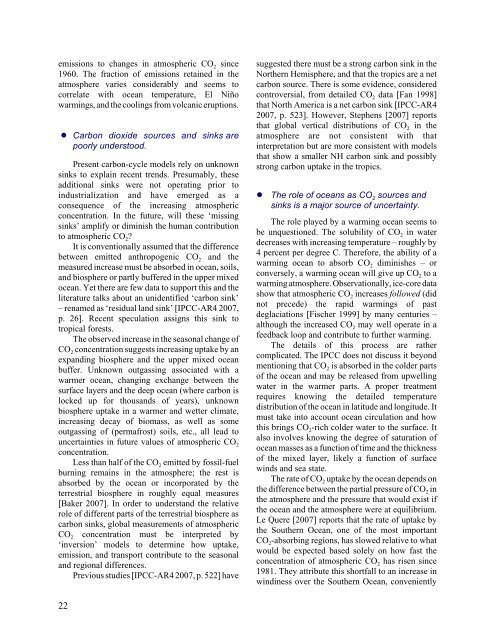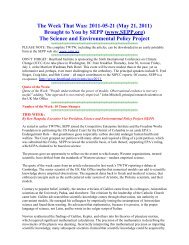Nature, Not Human Activity, Rules the Climate - Science ...
Nature, Not Human Activity, Rules the Climate - Science ...
Nature, Not Human Activity, Rules the Climate - Science ...
Create successful ePaper yourself
Turn your PDF publications into a flip-book with our unique Google optimized e-Paper software.
emissions to changes in atmospheric CO 2 since1960. The fraction of emissions retained in <strong>the</strong>atmosphere varies considerably and seems tocorrelate with ocean temperature, El Niñowarmings, and <strong>the</strong> coolings from volcanic eruptions.! Carbon dioxide sources and sinks arepoorly understood.Present carbon-cycle models rely on unknownsinks to explain recent trends. Presumably, <strong>the</strong>seadditional sinks were not operating prior toindustrialization and have emerged as aconsequence of <strong>the</strong> increasing atmosphericconcentration. In <strong>the</strong> future, will <strong>the</strong>se ‘missingsinks’ amplify or diminish <strong>the</strong> human contributionto atmospheric CO 2 ?It is conventionally assumed that <strong>the</strong> differencebetween emitted anthropogenic CO 2 and <strong>the</strong>measured increase must be absorbed in ocean, soils,and biosphere or partly buffered in <strong>the</strong> upper mixedocean. Yet <strong>the</strong>re are few data to support this and <strong>the</strong>literature talks about an unidentified ‘carbon sink’– renamed as ‘residual land sink’ [IPCC-AR4 2007,p. 26]. Recent speculation assigns this sink totropical forests.The observed increase in <strong>the</strong> seasonal change ofCO 2 concentration suggests increasing uptake by anexpanding biosphere and <strong>the</strong> upper mixed oceanbuffer. Unknown outgassing associated with awarmer ocean, changing exchange between <strong>the</strong>surface layers and <strong>the</strong> deep ocean (where carbon islocked up for thousands of years), unknownbiosphere uptake in a warmer and wetter climate,increasing decay of biomass, as well as someoutgassing of (permafrost) soils, etc., all lead touncertainties in future values of atmospheric CO 2concentration.Less than half of <strong>the</strong> CO 2 emitted by fossil-fuelburning remains in <strong>the</strong> atmosphere; <strong>the</strong> rest isabsorbed by <strong>the</strong> ocean or incorporated by <strong>the</strong>terrestrial biosphere in roughly equal measures[Baker 2007]. In order to understand <strong>the</strong> relativerole of different parts of <strong>the</strong> terrestrial biosphere ascarbon sinks, global measurements of atmosphericCO 2 concentration must be interpreted by‘inversion’ models to determine how uptake,emission, and transport contribute to <strong>the</strong> seasonaland regional differences.Previous studies [IPCC-AR4 2007, p. 522] havesuggested <strong>the</strong>re must be a strong carbon sink in <strong>the</strong>Nor<strong>the</strong>rn Hemisphere, and that <strong>the</strong> tropics are a netcarbon source. There is some evidence, consideredcontroversial, from detailed CO 2 data [Fan 1998]that North America is a net carbon sink [IPCC-AR42007, p. 523]. However, Stephens [2007] reportsthat global vertical distributions of CO 2 in <strong>the</strong>atmosphere are not consistent with thatinterpretation but are more consistent with modelsthat show a smaller NH carbon sink and possiblystrong carbon uptake in <strong>the</strong> tropics.! The role of oceans as CO 2 sources andsinks is a major source of uncertainty.The role played by a warming ocean seems tobe unquestioned. The solubility of CO 2 in waterdecreases with increasing temperature – roughly by4 percent per degree C. Therefore, <strong>the</strong> ability of awarming ocean to absorb CO 2 diminishes – orconversely, a warming ocean will give up CO 2 to awarming atmosphere. Observationally, ice-core datashow that atmospheric CO 2 increases followed (didnot precede) <strong>the</strong> rapid warmings of pastdeglaciations [Fischer 1999] by many centuries –although <strong>the</strong> increased CO 2 may well operate in afeedback loop and contribute to fur<strong>the</strong>r warming.The details of this process are ra<strong>the</strong>rcomplicated. The IPCC does not discuss it beyondmentioning that CO 2 is absorbed in <strong>the</strong> colder partsof <strong>the</strong> ocean and may be released from upwellingwater in <strong>the</strong> warmer parts. A proper treatmentrequires knowing <strong>the</strong> detailed temperaturedistribution of <strong>the</strong> ocean in latitude and longitude. Itmust take into account ocean circulation and howthis brings CO 2 -rich colder water to <strong>the</strong> surface. Italso involves knowing <strong>the</strong> degree of saturation ofocean masses as a function of time and <strong>the</strong> thicknessof <strong>the</strong> mixed layer, likely a function of surfacewinds and sea state.The rate of CO 2 uptake by <strong>the</strong> ocean depends on<strong>the</strong> difference between <strong>the</strong> partial pressure of CO 2 in<strong>the</strong> atmosphere and <strong>the</strong> pressure that would exist if<strong>the</strong> ocean and <strong>the</strong> atmosphere were at equilibrium.Le Quere [2007] reports that <strong>the</strong> rate of uptake by<strong>the</strong> Sou<strong>the</strong>rn Ocean, one of <strong>the</strong> most importantCO 2 -absorbing regions, has slowed relative to whatwould be expected based solely on how fast <strong>the</strong>concentration of atmospheric CO 2 has risen since1981. They attribute this shortfall to an increase inwindiness over <strong>the</strong> Sou<strong>the</strong>rn Ocean, conveniently22





